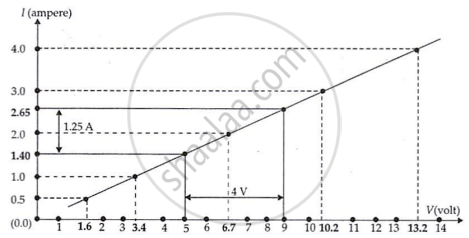Advertisements
Advertisements
प्रश्न
The values of current I flowing in a given resistor for the corresponding values of potential difference V across the resistor are given below:
| I (amperes) | 0.5 | 1.0 | 2.0 | 3.0 | 4.0 |
| V (volts) | 1.6 | 3.4 | 6.7 | 10.2 | 13.2 |
Plot a graph between V and I and calculate the resistance of that resistor.
उत्तर
The plot between voltage and current is called IV characteristic. The voltage is plotted on x-axis and current is plotted on y-axis. The values of the current for different values of the voltage are shown in the given table.
| V (volts) | 1.6 | 3.4 | 6.7 | 10.2 | 13.2 |
| I (amperes) | 0.5 | 1.0 | 2.0 | 3.0 | 4.0 |
The IV characteristic of the given resistor is plotted in the following figure.

For V = 4 V (i.e., 9 V − 5 V)
I = 1.25 A (i.e., 2.65 A − 1.40 A).
∴ `"R" = "V"/"I"`
= `(4 "V")/(1.25 "A")`
= 3.2 Ω
The accuracy of the graph's plotting determines the value of R that is found on it.
APPEARS IN
संबंधित प्रश्न
How much energy is given to each coulomb of charge passing through a 6 V battery?
Calculate the quantity of heat produced in a 20 Ω resistor carrying 2.5 A current in 5 minutes.
The values of current (I) flowing through a given resistor of resistance (R), for the corresponding values of potential difference (V) across the resistor are as given below:
| V (volts) | 0.5 | 1.0 | 1.5 | 2.0 | 2.5 | 3.0 | 4.0 | 5.0 |
| I (amperes) | 0.1 | 0.2 | 0.3 | 0.4 | 0.5 | 0.6 | 0.8 | 1.0 |
Plot a graph between current (I) and potential difference (V) and determine the resistance (R) of the resistor.
What is the potential difference between the terminals of a battery if 250 joules of work is required to transfer 20 coulombs of charge from one terminal of battery to the other?
Name the law which relates the current in a conductor to the potential difference across its ends.
Keeping the resistance constant, the potential difference applied across the ends of a component is halved. By how much does the current change?
What is Ohm's law? Explain how it is used to define the unit of resistance.
Why do electricians wear rubber hand gloves while working with electricity?
For the circuit shown in the diagram below:

What is the value of:
(i) current through 6 Ω resistor?
(ii) potential difference across 12 Ω resistor?
Calculate the potential difference between the two terminals of a battery if 100 joules of work is required to transfer 20 coulombs of charge from one terminal of the battery to the other.
Water in the waterfall flows from a higher level to the lower level because of ____________.
Point out two differences between e.m.f. and potential difference as applied to electric circuits.
Explain why potential difference is always less than the e.m.f. of a cell?
A cell of e.m.f 2.0 V and internal resistance 1Ω is connected to the resistors of 3Ω and 6Ω in series. Calculate:
(i) the current drawn from the cell,
(ii) the p.d. across each resistor,
(iii) the terminal voltage of the cell and
(iv) the voltage drop.
A current of 0.2 A flows through a conducting wire for 5 minutes. How much charge will flow?
Potential near a charge is the measure of its ______ to bring a positive charge at that point.
How will you conclude that the same potential difference (voltage) exists across three resistors connected in a parallel arrangement to a battery?
Find out the following in the electric circuit given in Figure
- Effective resistance of two 8 Ω resistors in the combination
- Current flowing through 4 Ω resistor
- Potential difference across 4 Ω resistance
- Power dissipated in 4 Ω resistor
- Difference in ammeter readings, if any.

Two charged spherical conductors of radius R1 and R2 are connected by a wire. Then the ratio of surface charge densities of the spheres (σ1/σ2 ) is ______
